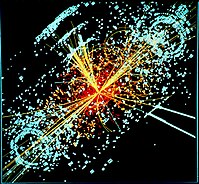
Photo from wikipedia
It is well known that general relativity is an effective theory of gravity at low energy scale, and actually quantum effects cannot be ignored in the strong-field regime. As a… Click to show full abstract
It is well known that general relativity is an effective theory of gravity at low energy scale, and actually quantum effects cannot be ignored in the strong-field regime. As a strong gravitational object, black hole plays a key role in testing the quantum effects of gravity in the strong-field regime. In this paper, we focus on black hole in effective loop quantum gravity and investigate what the influences are of the quantum effects on the weak and strong bending angles of light rays. We find that this black hole could be a Schwarzschild black hole, a regular black hole, a one-way traversable wormhole, or a two-way traversable wormhole for the different values of the quantum parameter, and the strong bending angle for this compact object exhibits two different divergent behaviors, i.e., the logarithmic divergence and non-logarithmic divergence. There are a series of relativistic images on both sides of the optical axis. Only the outermost one can be resolved as a single image, and all others are packed together at the limiting angular position. It is interesting to note that the angular separation between the outermost relativistic image and the others initially increases and then decreases as the quantum parameter increases, indicating that there is a maximum in the angular separation. The maximum is reached after the black hole becomes a wormhole, which can be taken as a signal for the formation of the wormhole. Moreover, the limiting angular position decreases as the quantum parameter increases but a little bounce occurs after the formation of the wormhole, and the relative magnification in magnitudes first decreases and then increases as the quantum parameter increases.
Journal Title: Physical Review D
Year Published: 2022
Link to full text (if available)
Share on Social Media: Sign Up to like & get
recommendations!